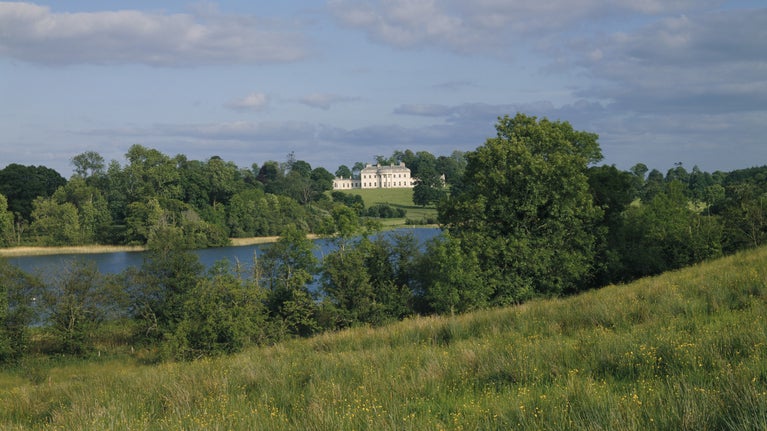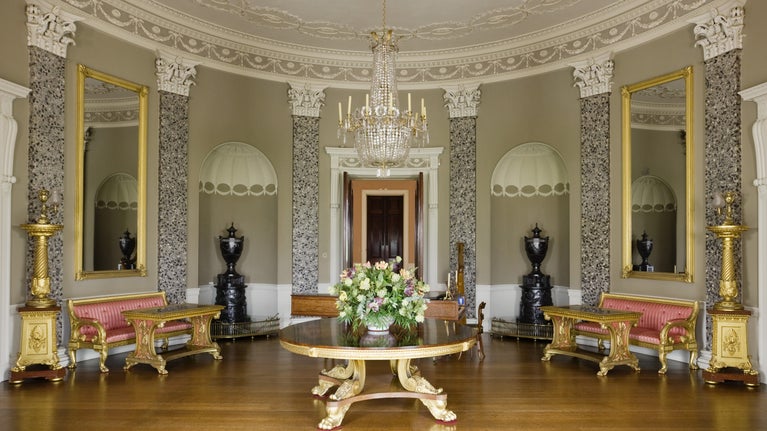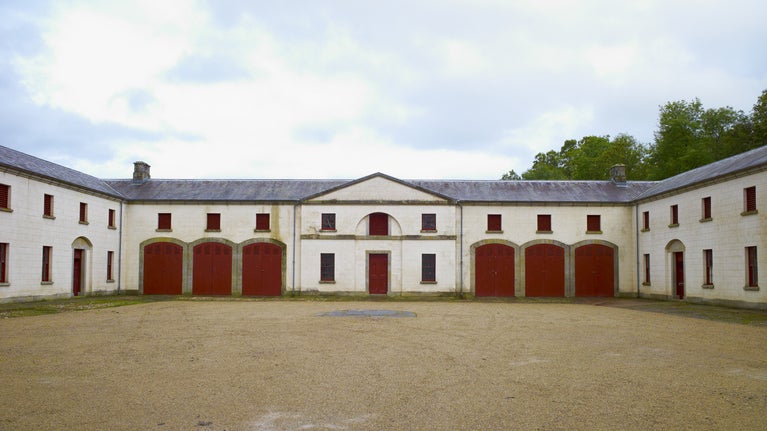
Discover more at Castle Coole
Find out when Castle Coole is open, how to get here, the things to see and do and more.

Castle Coole lies in the valley of the River Erne – a typical Fermanagh landscape of undulating, green pasture studded with small loughs. It has been a site of military, ecclesiastical and political power since at least the medieval period. A succession of elite landowners have left their mark here, from the Irish lords of Fermanagh to English soldiers of fortune, from merchant kings to the new aristocracy of the Irish Ascendancy. The pinnacle of their aspiration can be enjoyed by visitors today: James Wyatt’s serene, late eighteenth-century architectural masterpiece overlooking Lough Coole, surrounded by acres of parkland and woodland.
For centuries the Maguire family dominated the medieval lordship of Fermanagh. From the mid twelfth century, Maguire kin gradually expanded their political power over a broad geographical area in the south and west of Ulster.
The Maguire barony of Cúile (Coole) lay on the eastern shores of Upper Lough Erne. It was home to the Maguires’ hereditary physicians, the Ó Cassidys of Coole. In 1484, after an internal feud that threatened to break apart the clan, Eamonn Maguire resigned the kingship of Fermanagh to a rival claimant and retired to Coole. It is possible that an artificial island which survives today in Lough Coole was one of the Maguire strongholds to which he retreated.

Following Elizabeth I’s efforts to regain control of Ireland, her successor, King James I and VI, consolidated military gains through his project of Plantation. This was a protracted process of colonial expansion across an island devastated by conflict.
In the early 1600s, Maguire lands in Fermanagh were transferred into the hands of English and Scottish settlers. English officer Captain Roger Atkinson was granted the Manor of Coole in 1611, as a reward for the successful command of troops in the Irish campaigns. As part of the conditions of the grant, Atkinson built a fortified house on the eastern bank of Lough Coole.
In the years after 1640 the estate passed through the hands of prosperous English tradesmen and merchants seeking to bolster their rising social standing. Eventually, Scottish merchant John Corry (d. 1683/5) acquired the Manor of Coole in 1655, on the proceeds of his successful Belfast trading enterprise. Having rebuilt Atkinson’s house – damaged in the Irish uprising of 1641 – and renamed it Castle Coole, John Corry and his descendants formed a connection with this place which continues to this day.
The Corrys consolidated their position over the next 150 years, moving from the world of business to military careers, making financially advantageous marriages and taking on roles in local governance and administration, regional and ultimately national politics.
Castle Coole was heavily damaged in 1689, to prevent its being taken over by Jacobite forces on their progress through Fermanagh. In 1709, Colonel James Corry (c. 1633–1718) commissioned the architect John Curle to design a new house, next to the 17th-century complex. This provided a more gracious style of living, suitable to the social milieu in which the Corrys now moved.
Curle may also have been responsible for the design of the formal gardens and wider landscape setting, with a fashionable linear layout of enclosed parks and long avenues. Remnants of this design can be appreciated in Castle Coole’s parkland today, including substantial earthworks that once supported terraced parterres, ‘wilderness’ walks and a bowling green behind the house.
From the 1720s to the 1770s, Castle Coole estate business was overseen by Margetson Armar (1700–73), a close relation who was to marry Colonel Corry’s granddaughter, Mary Corry (1710–74). The couple invested heavily in the house and grounds, funded largely by canny estate management.

The personal drive of Armar Lowry Corry (1740–1802) forced a step change in the family’s pursuit of social advancement and political influence. In 1780, a year after inheriting the estate, he was raised to the peerage as Baron Belmore of Castle Coole.
Lord Belmore planned radical changes to the demesne, appropriate to his rising status. He chose higher ground overlooking Lough Coole for the site of a new residence, planned to sit at the heart of a naturalistic, parkland landscape. Over the next 80 years the parks and woodlands were developed gradually, responding to successive fashions in garden philosophy.
Designed by James Wyatt, the house itself was an essay in severe classicism, in which the play of light and shade was paramount, both inside and out. Vast in scale, the new Castle Coole was much more akin to an urban public building than a domestic country residence, an overt signal of Belmore’s political ambitions.
Construction of the new house by an English architect reflected a general move away from Irish designers, craftsmen and materials in the later eighteenth century. Faced in Portland stone from Dorset, Castle Coole’s decorative detailing was largely the product of London-based craftsmen from Wyatt’s circle including plasterer Joseph Rose, scagliolista Domenico Bartoli and sculptor Richard Westmacott. Mahogany doors were also made in London, although other fittings and furniture designed by Wyatt were created on site by a team which included Irish joiners.
On the surface all seemed set fair. Armar Lowry Corry had gained ever-increasing political influence, becoming 1st Earl of Belmore in 1797. The country seat intended as a political powerhouse was nearly complete. But costs had come in at double the budget, and his health and energy were failing. When he died in 1802, Belmore left debts of about £11 million in today’s terms.

Lord Belmore and his son, Somerset (1774–1841), had both taken a strong stand against proposals to unite Great Britain and Ireland. The Acts of Union of 1800 marked the end of the road for the family’s political aspirations.
The 2nd Earl invested in his social position through conspicuous consumption, hoping to manoeuvre himself back into royal and political favour. Between 1807 and 1825, the Dublin firm Preston and Sons decorated and furnished Castle Coole in glamorous style, akin to that adopted by the Prince Regent. And while Belmore toured the Mediterranean with his family on a four-year expedition, impressive stables were built at Castle Coole, with room for 40 horses.
In constant need of funds, Lord Belmore obtained the lucrative Governorship of Jamaica in 1828. With no administrative experience, his term of office saw the largest revolt of enslaved people in British colonial history. Recalled to London in disgrace, Belmore was eventually exonerated by the government. Public reaction to the violence surrounding the Jamaican uprising is thought to have precipitated the Slave Emancipation Act of 1833.
The 2nd Earl was never able to regain the political influence he desired. The debts encumbering the estate at his death would equate to about £26 million today.
The estate was eventually placed in Chancery during the minority of the 4th Earl to avoid bankruptcy, and most of the land was sold. Finances continued to be a problem over succeeding decades, with the family spending a good deal of time abroad where they could live more cheaply.
After WWII, even quiet country house life became unsustainable. In 1951 the National Trust purchased the house and part of the demesne with a grant from the Ulster Land Fund. Between 1979 and the early 1990s the Trust undertook several major conservation projects – stonework, roof and window repairs, rewiring, and redecoration of all the principal public rooms. Conservation work is ongoing, ensuring visitors to Castle Coole and its landscape can continue to enjoy this remarkable place.
Brindle, S. 2023. Architecture in Britain and Ireland 1530-1830. Yale: Yale University Press
Lowry Corry, S. R. 1881. The history of the two Ulster manors of Finagh, in the county of Tyrone, and Coole, otherwise manor Atkinson, in the county of Fermanagh, and of their owners. London: Longmans Green and Co.
Lowry Corry, S. R. 1891. The History of the Corry Family of Castlecoole. London: Longmans Green and Co.
Marson, P. 2007 Belmore: The Lowry Corrys of Castle Coole, 1646-1913. Belfast: Ulster Historical Foundation
Martin Robinson, J. 2012. James Wyatt: Architect to George III. Yale: Yale University Press

Find out when Castle Coole is open, how to get here, the things to see and do and more.
Step inside one of the finest neo-classical houses in Ireland, experience the ornate interiors and explore the extensive servant’s’ world below stairs.

Learn about people from the past, discover remarkable works of art and brush up on your knowledge of architecture and gardens.

From landscape gardeners to LGBTQ+ campaigners and suffragettes to famous writers, many people have had their impact on the places we care for. Discover their stories and the lasting legacies they’ve left behind.

Explore the objects and works of art we care for at Castle Coole on the National Trust Collections website.
